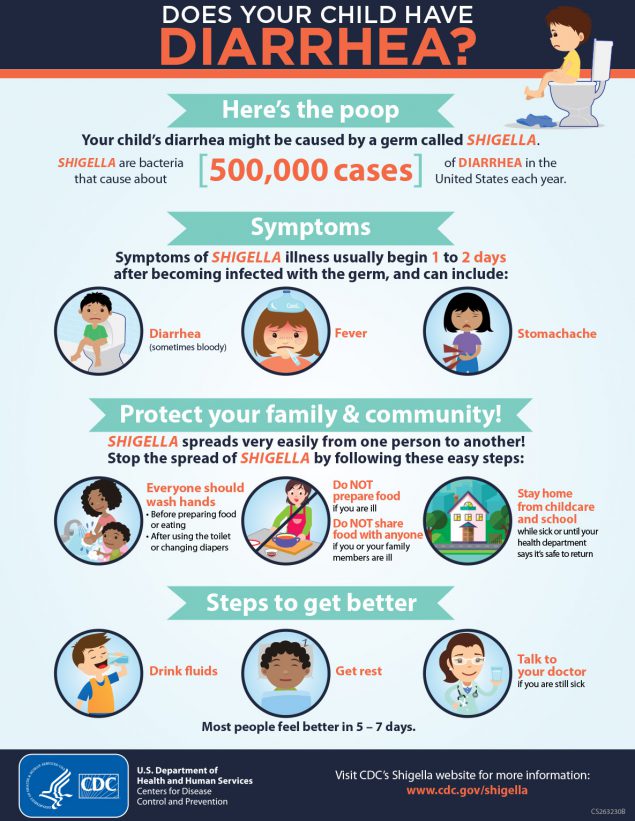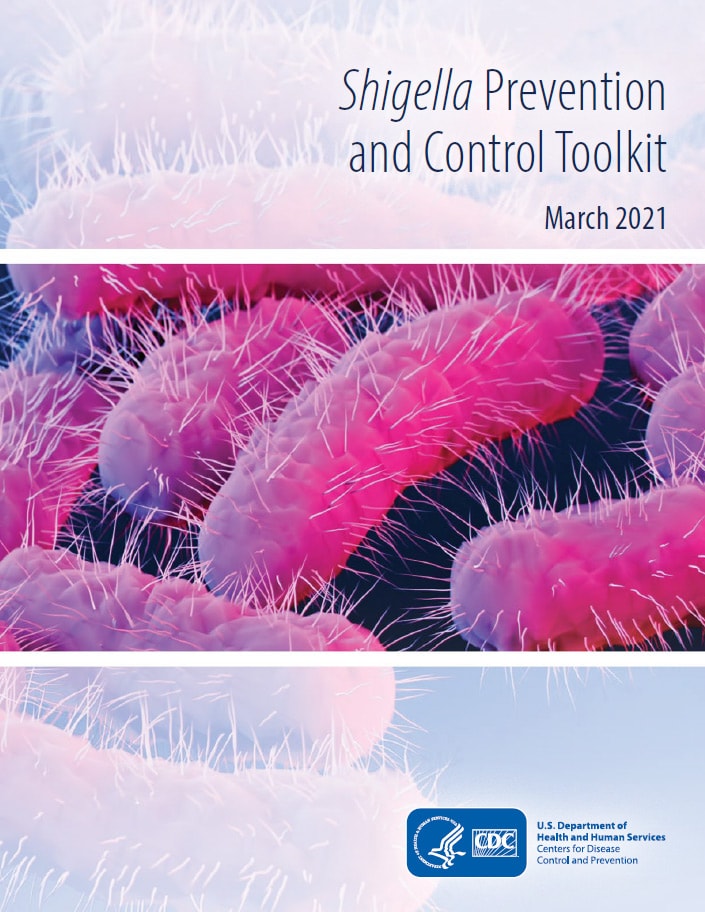Preventing and Controlling Shigellosis Outbreaks in Early Care and Education Facilities

Children younger than 5 years are the most likely to get shigellosis, but people of all ages can get this disease. Many outbreaks are related to early care and education settings and schools because Shigella germs spread from young children to their family members and others in their community.
Follow these steps to prevent shigellosis outbreaks in your program facilities and control them if they occur.
Educate staff and parents.
- Inform all early care and education staff about the symptoms of shigellosis, how Shigella germs spread from person to person, and control measures to be followed, like regular handwashing and good diapering practices.
- Inform parents about the symptoms of shigellosis, how germs spread, what to do during an outbreak, and hygiene and cleanliness procedures to reduce spread in the facility and at home.
Promote frequent handwashing.

Download Shigella print materials or order free from CDC-Info on Demand.
- Follow CDC’s five steps to washing hands the right way.
- Schedule and supervise handwashing of all children during the following times:
- Upon arrival at the childcare facility
- After they use the bathroom
- After having their diapers changed
- After playing outside
- After blowing their noses
- Before eating snacks or meals
- Before leaving the facility
- Encourage frequent handwashing among staff, especially during key times when germs are likely to spread:
- Upon arrival at the facility
- Before eating or preparing food
- After using the bathroom
- After changing diapers or cleaning up a child who has used the bathroom
- After helping a child blow his or her nose
- Before and after caring for a child who is sick with diarrhea, including after touching clothing, bedding, toilets, toys, or other surfaces touched by the child
Encourage healthy diapering practices.
- Separate diaper-changing areas from play and food preparation areas.
- Ensure children wear clothing over their diapers to prevent the spread of germs.
- Wash hands (both yours and the child’s) after each diaper change.
- Where staffing permits, people who change diapers should not prepare or serve food.
- Follow CDC’s recommended Safe and Healthy Diapering Steps for Childcare Settings.
Clean and disinfect toys and surfaces regularly.
- Toys, surfaces, and other objects in childcare centers and other facilities often have germs that can cause illnesses. If a shigellosis outbreak happens, clean and disinfect toys, surfaces, and objects more often to reduce the chance of spreading Shigella infection.
- Consider creating a schedule that helps staff routinely clean and disinfect surfaces and objects, especially those that children and staff regularly touch.
Establish and enforce rules on water play and swimming.
- Do not use inflatable or plastic kiddie pools or inflatable water slides in early care and education programs.
- It is not safe to use bleach or pool disinfectant (such as chlorine or bromine) in the water in these types of pools. Because disinfectants are not added to the water, germs can spread more easily in these pools.
- Do not use water tables or basins of water because they can spread germs.
- In facilities choosing to use them, have children and staff wash their hands before and after water play.
If a shigellosis outbreak happens, do not allow children to play in the water or swim for two weeks after diarrhea has completely stopped.
- If your childcare facility has access to water venues (such as swimming pools or splash pads):
- Follow CDC’s steps for healthy and safe swimming practices.
- Do not allow them to go in the water until 2 weeks after their diarrhea has completely stopped.
- Have children and staff shower with soap before getting in the water.
- If a child is too young to shower on their own, have staff wash the child, particularly their rear end, with soap and water.
- Have potty-trained children take frequent bathroom breaks.
- Have staff check diapers every hour.
- Change diapers in a diaper-changing area or bathroom. Do not change diapers by the water.
- Tell children to keep water out of their mouths and not to swallow it.
Exclude children with diarrhea from the childcare setting until the diarrhea has stopped.
- If an outbreak happens, notify parents of children who have been in contact with a sick person. Parents should contact the child’s healthcare provider if their child develops diarrhea.
- Children who recently recovered from shigellosis can be grouped together in one classroom to reduce spreading Shigella germs to children who were not sick, depending on local health regulations.
- Adults who recently recovered from shigellosis can be moved to jobs that are less likely to spread Shigella (for example, administrative work instead of food preparation), depending on local health regulations.
Notify the local or state health department about shigellosis cases
- Shigellosis is a reportable condition in all states, meaning all cases must be reported to the state or local health department.
- Notify your state or local health department if someone at your childcare facility, including a child or staff member, has been diagnosed with shigellosis.
- Reporting cases of shigellosis to the health department helps to identify outbreaks.
- Refer to your state health department website for information on how to contact your local health department.
- Your state or local health department will contact the patient (or a child’s family member) to:
- Learn about the patient’s illness
- Recommend ways to prevent the spread of Shigella to other people
- Say when it is safe to return to the program
- Public health departments do not share personal information, such as name and birthdate, to protect the privacy of the patient.
More Information
- Prevent Shigella Infection
- CDC Web-Based Training: Clean Hands and Spaces (Spanish)
- Health Promotion Materials
- Shigella—Child Care and Schools – American Academy of Pediatrics
- Caring for Our Children: Cleaning, Sanitizing, and Disinfecting – National Resource Center
- Shigella Infections 2021 Red Book
Page last reviewed: June 15, 2022
